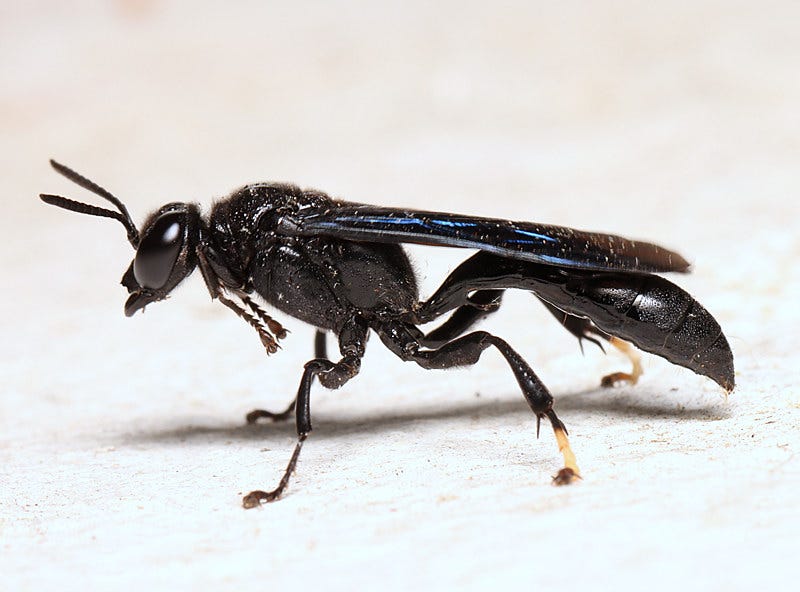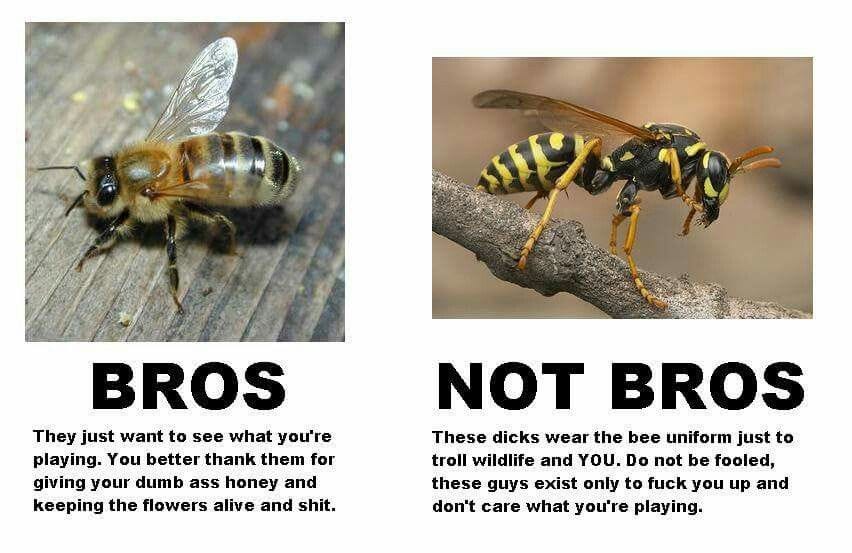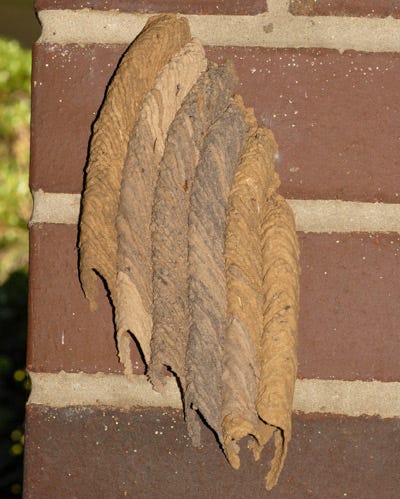ISSUE #05: Organ Pipe Mud Daubers Make Pottery Inside Your Garage
The first in my informal “Wasps Are Good” series.
Hello, and Happy Monday! You may be wondering: Why is Bugstack, traditionally a Friday publication, going up on a Monday?? The answer is simple: I thought I had scheduled the post on Thursday night as I always do, I didn’t do it right, and then left for a wedding in a place with minimal service and no laptop. I noticed only when my mom texted me asking if everything was all right, thinking, as you all likely were, that only a catastrophe on an international scale could keep me from posting.
Happily, everything is fine, I am fine, and, most importantly, the bugs are fine. Thank you for your patience during this period of technical difficulties. Let’s get back into it.
Our culture has been overtaken by a political dichotomy so fierce and misplaced that it threatens our very ecosystem. That’s right, I’m talking about bees vs. wasps. We’ve seen the posts: Bees are nice and cute and wasps are mean and bad. Bees are furry and wasps are scary looking. Bees make honey and wasps just make noise. The “save the bees” movement and our long history of farming honey have done a lot for one party in this issue, but what about wasps? Are they really as bad as all those memes would have us believe?
No.
Wasps are great, and, wasp by wasp, I am going to tell you why.
This post was inspired in part by one of our readers, Brian, who recently sent me some great photos of a wasp nest—a bald-faced hornet, it turns out—he found in one of his trees.
We’re starting with one of my favorites, the poetically named organ pipe mud dauber. When you think of a wasp nest, you likely think of the melon-shaped paper nests that hang in trees begging for a cartoon character to swing at them with a stick. Mud daubers are unique: instead of leaves, they use mud to make their nests, giving them an unmistakable shape. Some, like the Asian mud dauber, make little pots big enough for only one developing wasp larva. The organ pipe mud dauber’s nests are unmistakable: instead of individual egg-shaped compartments, their nests are shaped like long tubes that they build onto any solid, flat, vertical surface sheltered from the rain.
They build the tubes using any nearby source of mud they can find, gathering little balls of it and flying back to their nest site. Mixing it in their mouths with saliva, they pat the mud into shape, layering it onto the outsides of their nest tubes. You can see the striations of mud in the above photo, different colors based on what kind of mud the wasp was able to find. In the video below, you can hear the buzzing noise the wasp makes by vibrating her thorax, sending soundwaves through the mud to liquefy it and make it easier to spread evenly.
Inside, the tubes are divided into sections, each full of one young wasp and all of the food (i.e. paralyzed spiders, yikes) that the adults have gathered for them. The male residents of the nest are given the task of guarding the bottom openings of the tubes, while the females are in charge of hunting and building. Once the wasps hatch, they eat their food supply and, when they’re full adults, they have to chew a hole in the side of the tube to emerge. Generally, the females build the tubes in rows—if they start stacking them, the offspring on the bottom will have a tougher time chewing their way out of there.
Adult organ pipe mud daubers are striking: fully black and shiny with unusually thin bodies and iridescent blue-purple wings. They’re also some of the most docile wasps you can find, just cruising around looking for mud puddles. Apparently, wasps enjoy arts and crafts projects as much as the rest of us.




